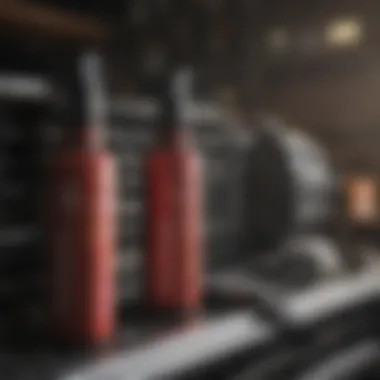Complete Honda Pilot Radiator Replacement Guide


Intro
Radiator replacement is a critical maintenance task for the Honda Pilot, a vehicle known for its reliability and performance. Understanding this process is essential for both seasoned automotive enthusiasts and those new to vehicle maintenance. This guide aims to demystify the radiator replacement procedure, providing step-by-step instructions, necessary tools, and post-replacement care suggestions. A well-maintained radiator ensures that your Honda Pilot operates efficiently, preventing overheating and extending engine life.
Vehicle Purchasing Behavior
Understanding how buyers approach vehicle purchases can illuminate why effective radiator maintenance is so vital. There are several factors influencing these decisions, from budget constraints to eco-friendliness.
Factors Influencing Vehicle Purchases
When purchasing a vehicle like the Honda Pilot, consumers often take into account several key elements:
- Reliability: Buyers often prioritize a vehicle known for its dependability to avoid unexpected repairs.
- Fuel Efficiency: The demand for eco-friendly vehicles impacts choices significantly, leading to higher interest in fuel-efficient models.
- Safety Features: Many consumers are keen on modern safety technologies, which are increasingly becoming a standard feature in vehicles.
- Maintenance Costs: Prospective buyers may consider long-term costs associated with maintenance, placing vehicles renowned for low maintenance requirements higher on their list.
Demographics of Buyers
The demographics of Honda Pilot buyers can also play a crucial role. The Pilot appeals to families and outdoor enthusiasts alike, often attracting those who value space and versatility. In particular, surveys suggest that the majority of buyers lean towards individuals aged 30-50, often with children, who appreciate the vehicle’s safety features and capacity.
Market Insights and Analysis
A comprehensive view of consumer behavior surrounding the Honda Pilot includes analyzing market trends and competitor offerings.
Consumer Behavior Analysis
Market research indicates that Honda Pilot consumers are often well-informed. They generally engage with reviews and forums to guide their purchasing decisions. This insight informs not just purchase patterns but also serves to highlight post-purchase behaviors, such as regular maintenance, which includes radiator upkeep.
Competitor Analysis
In the competitive landscape, vehicles like the Toyota Highlander and Ford Explorer pose significant competition. Each competitor boasts unique features, yet what stands out for the Pilot is its reputation for reliability and ease of maintenance. This edge emphasizes the importance of addressing maintenance tasks like radiator replacement, which can directly impact a vehicle's longevity.
"Regular maintenance is crucial for ensuring that the Honda Pilot remains a reliable family vehicle for years to come."
Epilogue
In summary, understanding the nuances of vehicle purchasing behavior, market insights, and basic radiator maintenance can impact the performance and value of a Honda Pilot. This guide will help both enthusiasts and regular drivers navigate the radiator replacement process effectively.
Prolusion to Radiator Functionality
Understanding radiator functionality is crucial for any Honda Pilot owner. The radiator plays a vital role in the vehicle’s cooling system. Its primary function is to dissipate the heat generated by the engine. This ensures that the engine operates within a safe temperature range, preventing overheating and potential engine damage.
A well-functioning radiator not only enhances engine performance but also extends the life of various engine components. If the radiator fails to operate correctly, the consequences can be severe, ranging from engine malfunctions to complete engine failure.
In this guide, we will delve into the specifics of radiator operation and identify key signs that indicate a failing radiator. Learning about these aspects will empower drivers to maintain their vehicles more effectively, ensuring optimal performance and longevity.
Role of the Radiator
The radiator serves as a heat exchanger. It cools the hot coolant that circulates through the engine. The coolant absorbs heat from the engine and, upon reaching the radiator, it releases that heat into the air. This process prevents the engine from overheating.
- Heat Transfer: As coolant moves through the radiator, it passes through a series of tubes surrounded by fins. Air flowing over these fins helps to dissipate heat efficiently.
- Pressure Regulation: The radiator cap plays an essential role in regulating pressure. It prevents the coolant from boiling by maintaining the right pressure levels.
- Fluid Recovery: Many radiators have an overflow reservoir. This allows coolant to return as it cools, maintaining optimal fluid levels.


By understanding the role of the radiator, Honda Pilot owners can appreciate its importance in maintaining engine health and overall vehicle performance.
Signs of a Failing Radiator
Identifying a failing radiator early can save drivers from costly repairs. Here are key indicators:
- Overheating Engine: If the temperature gauge frequently points toward the red zone, it is a clear sign of radiator issues.
- Coolant Leaks: Puddles of coolant under the vehicle can indicate a leak in the radiator. This requires prompt attention.
- Unusual Engine Noises: Gurgling or bubbling noises while the engine is running may suggest air pockets in the cooling system, often linked to radiator malfunctions.
- Steam from Engine Compartment: Visible steam can mean the coolant is boiling, often due to a radiator that is not functioning correctly.
Recognizing these signs early can prevent further damage and lead to timely replacement or repairs, ensuring the Honda Pilot continues to operate smoothly.
Overview of Honda Pilot Radiator
The Honda Pilot radiator plays a vital role in maintaining the vehicle's engine temperature, thereby ensuring optimal performance. Understanding the specifications and compatibility of the radiator is crucial for any replacement process. This section delves into the essential details about the radiator, which will aid both novices and seasoned mechanics alike in their maintenance and repair endeavors.
Specifications and Types
The radiator in the Honda Pilot is designed to facilitate efficient heat exchange and coolant circulation. Typically, these radiators are made from aluminum or plastic materials, which provide lightweight and corrosion-resistant properties. Specific models may vary slightly in dimensions, but most Honda Pilot radiators adhere to similar specifications. Key specifications include:
- Core Thickness: The standard core thickness generally measures between 1 and 3 inches, carefully crafted to maximize coolant flow while minimizing weight.
- Inlet and Outlet Size: The inlet and outlet size often remains consistent across model years, usually around 1.5 inches in diameter, ensuring compatibility.
- Cooling Capacity: The radiator is designed to handle a specific heat load, typically ranging from 15,000 to 25,000 British Thermal Units (BTUs) per hour, which is essential for maintaining engine temperature during various driving conditions.
- Mounting Configurations: Radiators come with pre-drilled holes and brackets for easy installation, tailored to fit the Honda Pilot’s chassis.
Understanding these specifications can streamline the replacement process and decrease the likelihood of compatibility issues.
Compatibility and Models
When it comes to radiator replacement, ensuring compatibility with specific Honda Pilot models is imperative. Different generations of the Pilot might have variations in their radiator designs, leading to potential mismatches if incorrect parts are used. Most importantly, it’s critical to verify aspects like:
- Model Year: The Honda Pilot has undergone various redesigns since its inception. Ensure that the selected radiator matches the manufacturing year of your vehicle, as alterations in size and mounting may exist.
- Engine Type: Different engine configurations, such as the 3.5-liter V6 or those including hybrid variations, can result in distinct radiator requirements. It’s essential to double-check your engine type for optimal performance.
- OEM vs Aftermarket: Original Equipment Manufacturer (OEM) parts generally guarantee a perfect fit and function, while aftermarket components may offer cost savings but could lead to future complications. Ensure that aftermarket options are reputable and meet OEM standards.
By considering these factors, owners can be more informed when selecting a replacement radiator for their Honda Pilot, ultimately enhancing their vehicle's longevity and reliability.
Preparation for Radiator Replacement
Preparing for a radiator replacement is crucial. The entire process can be daunting without proper preparation, but it greatly simplifies the task ahead. Understanding the various elements involved not only enhances efficiency but also increases safety. This preparation phase ensures that every aspect is covered, minimizing surprises during the replacement.
Essential Tools Needed
To successfully replace the radiator in a Honda Pilot, certain tools are necessary. Here is a comprehensive list:
- Socket Wrench Set: Different sizes may be required to fit various bolts.
- Pliers: Useful for loosening tightly fastened hoses.
- Screwdrivers: Both flat and Phillips types are needed.
- Coolant Drain Pan: To catch old coolant when draining.
- Radiator Hose Clamp Tool: This tool can make removing hoses easier.
- Safety Goggles and Gloves: For protection against hot coolant and sharp metal parts.
- Torque Wrench: To ensure bolts are tightened to the correct specifications.
Having the right tools on hand avoids interruptions and keeps the workspace organized. It also reflects a professional attitude towards vehicle maintenance.
Safety Precautions
Safety cannot be overstated when replacing a radiator. The components involved, such as hot coolant and sharp metal edges, pose risks. Here are some essential safety precautions:
- Let the Engine Cool: Always wait for the engine to cool down before beginning. Touching hot parts can cause burns.
- Wear Protective Gear: Safety goggles and gloves protect against splashes and cuts.
- Work in a Ventilated Area: If working indoors, ensure adequate ventilation to avoid inhalation of fumes.
- Keep Fire Extinguishers Nearby: Useful in case of unexpected fires, especially if working with flammable liquids.
- Use a Drain Pan: Catching coolant ensures that spills are avoided, which can be a slipping hazard.
Planning and preparing can greatly influence the outcome of the radiator replacement. These considerations not only enhance effectiveness but also ensure the safety of everyone involved.


Step-by-Step Radiator Replacement Process
The radiator replacement process is a critical procedure for maintaining optimal engine performance in the Honda Pilot. Understanding this process helps both enthusiasts and professionals perform replacements safely and efficiently. Doing it right can prevent future issues like overheating or coolant leaks. The following subsections will provide easy-to-follow instructions detailing each step necessary for a successful radiator replacement.
Drain the Coolant
Before beginning the replacement process, draining the coolant is essential. This step ensures that you do not spill coolant during the removal of the radiator. To drain the coolant, locate the drain valve at the bottom of the radiator. Open this valve and allow the coolant to flow into a suitable container. It is important to use a container designed to hold liquids, as coolant can be harmful to both pets and the environment.
Ensure the engine is cool before you start. It’s advisable to wear gloves during this step, as coolant can be toxic. Dispose of the used coolant at a recycling center that accepts automotive fluids. This is crucial for both environmental and safety reasons.
Remove Radiator Hoses
Once the coolant is drained, the next step is removing the radiator hoses. There are typically two hoses connected to the radiator: the upper and lower hoses. Start by loosening the hose clamps with a screwdriver or pliers. Carefully twist and pull each hose off the connection points. Pay attention to the condition of these hoses; if they are brittle or worn, it may be wise to replace them during the process. This ensures the longevity of the new radiator and helps prevent future leaks that can lead to overheating.
Unfasten Radiator Mounting Bolts
With the hoses removed, the next step is to unfasten the radiator mounting bolts. Depending on the specific model of your Honda Pilot, the number and location of these bolts may vary. Use a socket wrench to carefully loosen and remove all bolts holding the radiator in place. It is important to keep these bolts in a secure location, as you will need them for reinstalling the new radiator.
Consider the mounting bracket since it might obstruct the radiator’s removal. Double-check that all bolts and connections are free to avoid damaging the new radiator or surrounding components.
Extract the Old Radiator
After all bolts are removed, you can now extract the old radiator. Be cautious while removing it, as some residual coolant may still be present. Lift the radiator out of the engine compartment carefully. If it does not come out easily, you may have missed a bolt or connection. Inspect for any additional attachments to ensure a smooth removal.
Once the old radiator is out, consider cleaning the surrounding area. This includes removing any debris or old coolant that could create problems when installing the new unit.
Install the New Radiator
Installation of the new radiator follows extraction. Place the new radiator into the mounting area, ensuring it fits snugly in place. Align it with the mounting brackets and ensure that all openings for hoses and sensors are correctly positioned. Once correctly aligned, fasten the mounting bolts to secure the radiator. Tighten them firmly but be careful not to over-torque, as this can damage the radiator.
It is essential to check that all necessary components are in place and properly fastened before moving to the next step.
Reconnect Hoses and Fill Coolant
Once the new radiator is secured, reconnect the upper and lower hoses. Make sure the hose clamps are tightened correctly to avoid leaks when the engine is running. After reconnecting the hoses, it's time to fill the radiator with the new coolant.
Refer to your Honda Pilot’s specifications for the recommended coolant type. Pour the coolant slowly into the radiator, ensuring there are no air bubbles trapped within the system. After filling, run the engine for a few minutes with the cap off to allow the coolant to circulate. This step ensures all air is removed from the system. Finally, check the coolant level and add more if necessary before sealing the radiator cap.
Ensure the coolant is filled to the appropriate level to prevent overheating.
Following these steps accurately will lead to a successful radiator replacement, ensuring the Honda Pilot functions optimally for years ahead.
Common Challenges During Replacement
Replacing the radiator in a Honda Pilot can be a rewarding task, but it is essential to recognize the challenges that can arise during this process. Understanding these challenges helps prepare you for potential difficulties, ensuring a smoother replacement experience.
Stubborn Bolts and Corrosion
One of the most frustrating aspects of radiator replacement is dealing with stubborn bolts. Over time, exposure to heat and coolant causes these bolts to corrode, making them hard to loosen. Using the wrong tools or excessive force can strip the bolts, complicating the removal process. To mitigate this risk, make sure to have a quality socket set and a breaker bar. Applying a penetrating lubricant can also help loosen stubborn bolts.


- Use the correct size: Ensure socket sizes are accurate to prevent stripping.
- Apply heat cautiously: A heat gun can work but be careful not to damage nearby components.
- Consider using a torque wrench: This tool helps ensure that bolts are not over-tightened during reinstallation, reducing the chance for future corrosion.
Coolant Leaks Post-Replacement
After replacing the radiator, ensuring there are no coolant leaks is critical for maintaining vehicle performance and preventing engine damage. Many factors contribute to possible leaks, including improper hose reconnections or disturbances in the sealing surfaces where the radiator meets the engine and the hoses.
To address this:
- Check all connections: Revisit all hoses and connections to ensure they are secure and correctly placed.
- Inspect for damage: During the installation, look for any cracks in the hoses or the radiator itself that might cause leaks.
- Pressure test: Conducting a pressure test can reveal any underlying leaks that might not be immediately visible.
"Preventing coolant leaks post-replacement is vital; even a small leak can lead to severe overheating issues."
Post-Replacement Procedures
After replacing the radiator in a Honda Pilot, certain procedures are essential to consolidate the work done and ensure long-term functionality and performance of the vehicle's cooling system. These post-replacement tasks help to verify that the installation is secure, checks for leaks, and maintains optimal temperature regulation going forward.
Testing for Proper Functionality
Testing the newly installed radiator is crucial. It helps to confirm that the vehicle operates as expected. Start by filling the cooling system with the appropriate coolant mixture if not already done. After that, follow these steps:
- Start the Engine: Let the engine idle until it reaches operating temperature. This action allows the thermostat to open and ensures that the coolant circulates properly.
- Monitor Temperature Gauge: Keep an eye on the temperature gauge on the dashboard. It should stay within the normal range. An abnormal temperature may suggest air pockets or other issues.
- Check for Leaks: Inspect the new radiator and the hoses for any signs of leaks. Look for drips or pooling coolant under the vehicle. Minor leaks can often be resolved with gentle tightening of hose clamps.
- Conduct a Pressure Test: If you have access to a pressure tester, use it to assess the integrity of the cooling system. A pressure test can highlight issues that may not be visible otherwise.
After these checks, if everything appears normal, allow the vehicle to cool down and recheck coolant levels, topping off as needed.
Routine Maintenance Tips
Proper routine maintenance is vital to prolong the lifespan of the radiator and the entire cooling system. Here are some practical tips:
- Regular Coolant Changes: Change the coolant according to the manufacturer's recommended schedule. Old coolant may lose effectiveness and lead to corrosion.
- Inspect Hoses and Clamps: Regularly check hoses for wear and tear. Ensure clamps are tight but avoid overtightening, which can damage hose connections.
- Monitor Temperature: Always keep an eye on the temperature gauge while driving. Unusual readings should prompt further investigation.
- Radiator Cleaning: Periodically clean the exterior of the radiator. Debris accumulation can hinder airflow, decreasing efficiency.
- Avoid Overheating: Be proactive about any signs of overheating, such as steam or vague temperature gauge reactions. Immediate attention can prevent catastrophic engine damage.
Overall, implementing these post-replacement procedures and maintenance tips can greatly enhance the vehicle’s performance and ensure that the investment in a new radiator pays off. Regular check-ups will prevent costly repairs and downtime while ensuring the Honda Pilot continues to run smoothly for years.
Culmination
The conclusion of this article encapsulates the essential components of radiator replacement for the Honda Pilot. Understanding the significance of correct radiator installation cannot be overstated. A well-functioning radiator is crucial for maintaining engine temperature and preventing overheating, which can lead to severe engine damage. Hence, a proper replacement ensures the longevity and efficiency of the vehicle.
Summary of Key Points
In summary, this guide has extensively covered various aspects of radiator replacement, focusing on:
- The role of the radiator in vehicle performance.
- Detailed steps for replacing a Honda Pilot radiator effectively.
- Common challenges one might encounter during the process.
- Post-replacement procedures to ensure everything is operating correctly, such as testing for leaks and maintaining regular checks.
- Tools and safety precautions needed to carry out this task efficiently.
These elements highlight the importance of thorough preparation and attention to detail during the entire process. Each step is integral to achieving a successful radiator replacement.
Final Thoughts on Radiator Care
Taking care of the radiator involves understanding its functionality and importance in the overall vehicle system. Always keep an eye on symptoms like overheating or leaks, as they are signs that attention is needed. Ensure routine maintenance, such as checking coolant levels and looking for signs of wear, is part of your automotive care regimen. This diligence can help maintain the vehicle’s performance and prevent costly repairs later on.
Investing time in proper radiator care reflects in the car's reliability and efficiency. Remember, a cautious approach can save both time and money in the long run.
"An ounce of prevention is worth a pound of cure."
For more information on vehicle maintenance, please refer to reputable sources such as Wikipedia and Britannica.
Engaging with communities on platforms like Reddit and Facebook can provide additional insights and tips from fellow enthusiasts and experts.















